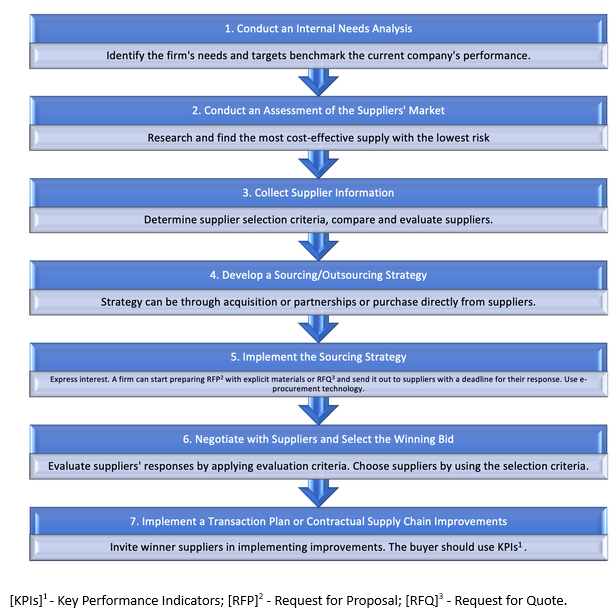3.2 Concept of Procurement and its Value in the Global Value Chain
Learning Objective
1. Explain the concept of procurement and how it adds value in the global value chain.
What is Procurement?
Mangan and Lalwani (2016) describe procurement as:
- “Procurement includes sourcing and purchasing and covers all of the activities from identifying potential suppliers through top delivery from supplier to the customer” ( p. 379).
- “Procurement is about specifying requirements, identifying sources, evaluating options, and acquiring resources that are fit for purpose, cost effective and sustainable” ( p. 144).
- Managing risks and value on behalf of the company is the role of procurement ( p. 148).
Globalization gives tremendous opportunities for companies to increase competitive advantages by using international sourcing or acquiring cutting-edge technologies. The process of purchasing services or goods worldwide to bid on contracts is called international procurement. The process is increasingly essential for organizations globally. It helps organizations enhance their competitive position, meet customer expectations, improve profits, and add value by finding suppliers who meet the organization’s strategy.
According to authors from “Production and Inventory Management Journal“, international procurement helps improve worldwide logistics capabilities, the source for small companies, and extend international procurement activities (Scully & Fawcett, 1994). However, specific knowledge and special skills are required to succeed in international procurement.
Procurement Process and Steps
Before delving deeper into the procurement steps, let’s look at the types of the procurement process.
Video: Types of Procurement Process (2:32)
This video gives an overview of the different types of procurement process used by Irish public bodies as well as information on how businesses can access these opportunities
Media 3.2 Types of Procurement Process. [Video]. Office of Government Procurement Ireland. (URL: https://www.youtube.com/watch?v=_490ZEaYdwA)
Consider This
Let us consider the procurement process in services such as Project Management. This is an example of a clear explanation of procuring goods and services. Some paragraphs adapted from Procurement Management by Adrianne Watt under Creative Commons Attribution Licence 4.0.
Procurement management follows a logical order. First, you plan what you need to contract; then you plan how you’ll do it. Next, you send out your contract requirements to sellers. They bid for the chance to work with you. You pick the best one, and then you sign the contract with them. Once the work begins, you monitor it to make sure that the contract is being followed. When the work is done, you close out the contract and fill out all the paperwork.
You need to start with a plan for the whole project. Before doing anything else, you need to think about all of the work that you will contract out for your project. You will want to plan for any purchases and acquisitions. Here’s where you take a close look at your needs to be sure that contracting is necessary. You figure out what kinds of contracts make sense for your project, and you try to define all of the parts of the project that will be contracted out.
Contract planning is where you plan out each individual contract for the project work. You work out how you’ll manage the contract, what metrics it will need to meet to be considered successful, how you’ll pick a seller, and how you’ll administer the contract once the work is happening.
(Watt, n.d.) CC-BY-4.0
The procurement process helps companies obtain and manage costs such as freight forwarders, human resources, capital assets, fuel, IT equipment, sales, utilities, marketing, legal and professional services, raw materials, facility management.
According to the book FITT “Global Value Chain” (2021), there are seven major steps in the procurement process: “Conduct an Internal Needs Analysis, Conduct an Assessment of the Suppliers’ Market, Collect Supplier Information, Develop a Sourcing/Outsourcing Strategy, Implement the Sourcing/outsourcing Strategy, Negotiate with Suppliers and Select the Winning BID, Implement a Transition Plan or Contractual Supply Chain Improvements”. These seven steps are visualized in the figure below. (FITT, 2021, p. 8).
Figure 3.1
Procurement Flow Chart
 Note. From FITT, 2021, p.8. Click to enlarge. [Image description].
Note. From FITT, 2021, p.8. Click to enlarge. [Image description].
Check Your Understanding
Explain the concept of procurement and how it adds value in the global value chain.
Answer the question(s) below to see how well you understand the topics covered above. You can retake it an unlimited number of times.
Use this quiz to check your understanding and decide whether to (1) study the previous section further or (2) move on to the next section.
Interactive activity unavailable in this format
Text-based alternative to interactive activity available in Chapter 3.7.
Overall Activity Feedback
Globalization gives tremendous opportunities for companies to increase competitive advantages by using international sourcing or acquiring cutting-edge technologies. The process of purchasing services or goods worldwide to bid on contracts is called international procurement. The process is increasingly essential for organizations globally. It helps organizations enhance their competitive position, meet customer expectations, improve profits, and add value by finding suppliers who meet the organization’s strategy.
According to authors from “Production and Inventory Management Journal”, International procurement helps improve worldwide logistics capabilities, the source for small companies, and extend international procurement activities (Scully & Fawcett, 1994). There are seven major steps in the procurement process. The process of purchasing services or goods worldwide to bid on contracts is called international procurement. The process is increasingly essential for organizations globally. It helps organizations enhance their competitive position, meet customer expectations, improve profits, and add value by finding suppliers who meet the organization’s strategy. Managing risks and value on behalf of the company is the role of procurement.
Media Attributions and References
FITT. (2021). FITTskills: Global Value Chain (7th Edition). Forum for International Trade Training (FITT). https://bookshelf.vitalsource.com/books/9781988782126
Office of Government Procurement Ireland. (2018, January 11). Types of Procurement Process. [Video]. YouTube. https://www.youtube.com/watch?v=_490ZEaYdwA

